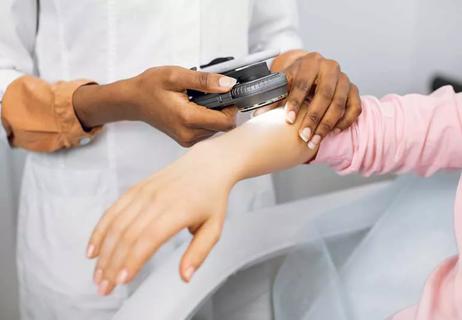Wear UPF clothing, apply sunscreen and try self-tanners instead of tanning beds

Skin cancer is the most common form of cancer in the United States. Each year, more than 1 million people in the U.S. are diagnosed with it. And yet, when the sun’s out, we’re so often drawn to it and run outside without taking the proper precautions.
Advertisement
Cleveland Clinic is a non-profit academic medical center. Advertising on our site helps support our mission. We do not endorse non-Cleveland Clinic products or services. Policy
It’s no secret that the sun’s rays can be harmful. Sunlight contains ultraviolet (UV) radiation, which can cause skin cancer. But you don’t have to become a hermit and hide from sunlight like a vampire. Cancer care nurse Josette Snyder, RN, MSN, AOCN, offers steps you can take to reduce your risk of skin damage from the sun — as well as skin cancer.
Sunscreen is an important part of sun protection year-round, but should especially be a staple in your medicine cabinet during the summer months. Look for a product that provides a sun protection factor (SPF) of 30 or higher. You also want a broad spectrum, which means it protects you from both UVA and UVB rays.
“About 30 minutes before you go outside, apply a thick coating — and be sure to reapply frequently because all sunscreens break down in the sun after two to three hours,” explains Snyder.
If you go in the water, reapply sunscreen after you dry off, even if it’s a water-resistant sunscreen. And it’s a good rule of thumb to reapply sunscreen every two hours, even if it says “all-day protection.”
Be sure to apply sunscreen in places often missed. These include your ears, the tops of your feet and your scalp.
Avoid the sun’s rays, especially during the midday hours of 10 a.m. to 3 p.m., when the sun is highest and its rays are most direct. You’ll want to seek shelter under an umbrella, tree or other shade before you need relief from its rays. If you’re in sunlight, keep an eye out for your skin turning pink or becoming sensitive.
Advertisement
By this point, however, know that damage is already happening to your skin. Ultraviolet rays can still reach you in the shade when you’re outside, so you need to use sunscreen or wear protective clothing no matter what.
Long-sleeved shirts and long pants and skirts can protect you from UV rays. Although light-colored, loosely woven clothing is popular during the warm months, you may be surprised to learn that garments that are dark-colored or made from tightly woven fabric give more protection against the sun. Sun-protective clothing physically blocks the sun’s rays, while the dark color absorbs them. Also, wet clothing offers much less UV protection than dry.
“A typical T-shirt has an SPF rating lower than 15, so don’t rely solely on clothing — use other types of protection as well, such as sunscreen,” advises Snyder. Several companies sell clothing with ultraviolet protection factor (UPF), a sun protective factor built into the clothing, which includes swimwear, T-shirts and hats.
Choose a hat with a wide brim that goes all the way around your head to shade your face, ears and neck. A tightly woven fabric, such as canvas, is best, and a darker hat may offer more UV protection. Avoid straw hats with holes that let sunlight through.
“If you wear a baseball cap, protect your ears and the back of your neck by wearing clothing that covers those areas, use a sunscreen with an SPF of at least 30, or stay in the shade,” Snyder says.
Sunglasses not only protect your eyes from UV rays and reduce the risk of cataracts, but they also protect the tender skin around your eyes from sun exposure. Most sunglasses sold in the United States, regardless of cost, block UV rays.
“Wrap-around sunglasses work best because they block UV rays that can come in from the side,” notes Snyder.
It’s widely known that tanning beds are linked to skin cancers, including melanoma — the deadliest type of skin cancer.
People who use tanning beds are 2.5 times more likely to develop squamous cell carcinoma and 1.5 times more likely to develop basal cell carcinoma. And it’s not just your skin that’s at risk: Exposure to the UV radiation that tanning beds emit can also cause cataracts and cancers of your eyes. Snyder says even occasional sunbed use almost triples your chances of developing melanoma. People who are younger — including teenagers — are especially sensitive to the UV rays that tanning beds emit.
If you really prefer the “healthy” glow of tanned skin, there are many sunless tanners and bronzers available that create that sun-kissed look without the risk of skin cancer. These are cosmetics applied to your skin, like a cream or spray, and can provide a temporary, artificial tan. The only color additive currently approved by U.S. Food and Drug Administration (FDA) for this purpose is dihydroxyacetone (DHA).
Advertisement
“If you do use a sunless tanner, be sure to still apply sunscreen when going out in the sun as most sunless tanning products don’t contain sunscreen,” says Snyder.
At the end of the day, in order to prevent skin cancer, you have to stay vigilant. This includes checking for changes in your skin tone and texture. If you’re older than 30, you shouldn’t be developing any new moles, so you’ll want to check once a month to see if you spot any new developments. You’ll also want to check existing spots for changes in size, color or shape. And if you see something “funny,” don’t hesitate to contact a healthcare provider.
Advertisement
Learn more about our editorial process.
Advertisement

Family history matters for melanoma, but the connection isn’t as strong for other skin cancers

The simple, straightforward and hard-lined answer is no

Frequent manicures, high-watt bulbs increase potential

The risk is less, but sunscreen is never a bad idea

Anything from minor irritations and chronic diseases to, yes, cancer can cause persistent itching

In some cases, itchiness can be a symptom of skin cancer

The who, what, why and how of skin checks

The Short Answer from a dermatologist

Type 2 diabetes isn’t inevitable with these dietary changes

Applying a hot or cold compress can help with pain